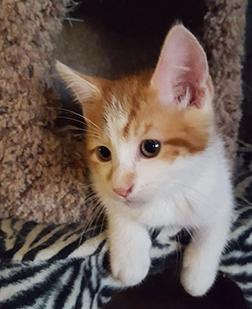
While your cat’s sensitive ears may discern the distinctive sound of a can of food being opened in the kitchen, a human’s helping hand can ensure those ears remain clear and clean by checking them weekly.
Begin with the outer ear. A healthy earflap (pinna) has a fine layer of hair on its outer surface with no visible bald spots, while its inner surface is clean and light pink. Should you notice any discharge, redness or swelling, have your cat’s ears examined by your vet.
To check the inner ear, fold it back gently and look down (a tiny penlight makes this easier) into the canal. A healthy inner ear is pale pink, is free of debris and odor, with minimal to no earwax. Should either or both of your cat’s ears be caked with wax (especially dark brown wax) or emit a foul odor, have them examined by your vet.
Otherwise, for maintenance, place a small amount of liquid ear cleaner (ask your vet to recommend one) onto a clean cotton ball or a piece of gauze. Fold your cat’s ear back gently and wipe away any debris or earwax from the underside of the ear. LIFT away the dirt and wax rather than rubbing it into the ear. And do NOT attempt to clean the ear canal. Probing the inside of your cat’s ear can cause injury or infection.
Monitor your cat for any of the following signs that may prompt an immediate visit to your vet:
Persistent scratching and pawing of the ear area
Sensitivity to touch
Head tilting or shaking
Loss of balance and disorientation
Hearing loss
Bleeding
There are also several ear disorders that can cause your cat harm and you alarm. Among them:
Ear mites, which are common parasites, and are highly contagious among pets. Telltale signs include excessive scratching of the ears and debris that resembles coffee grounds.
Ear blisters (hematomas), a collection of blood and serum between the cartilage and skin of your cat’s outer ear, often caused by infection, ear mites, fleas or trapped debris, that results in continuous ear scratching or excessive head shaking.
Ear infections, usually caused by bacteria, yeast or foreign debris caught in your cat’s ear canal. See your vet promptly because ear infections are not only extremely uncomfortable, but they may also be indicators of allergies, hormonal abnormalities or hereditary diseases.
Should your vet recommend ear drops or ointment for your cat, get advice on how to properly administer them or follow the general guidelines below:
Read the label instructions carefully to be assured of the correct dosage. If there’s debris or excessive wax in your cat’s outer ear or visible ear canal, gently wipe the external ear with a cotton ball or gauze moistened with your liquid ear cleaner. Gently pull back the earflap and squeeze out the correct amount of solution or ointment into the outermost ear canal, then lightly massage the base of your cat’s ear to help work the medication deeper into the canal. Make certain to complete the entire course of treatment, thereby ensuring that the issue has been resolved.









 RSS Feed
RSS Feed